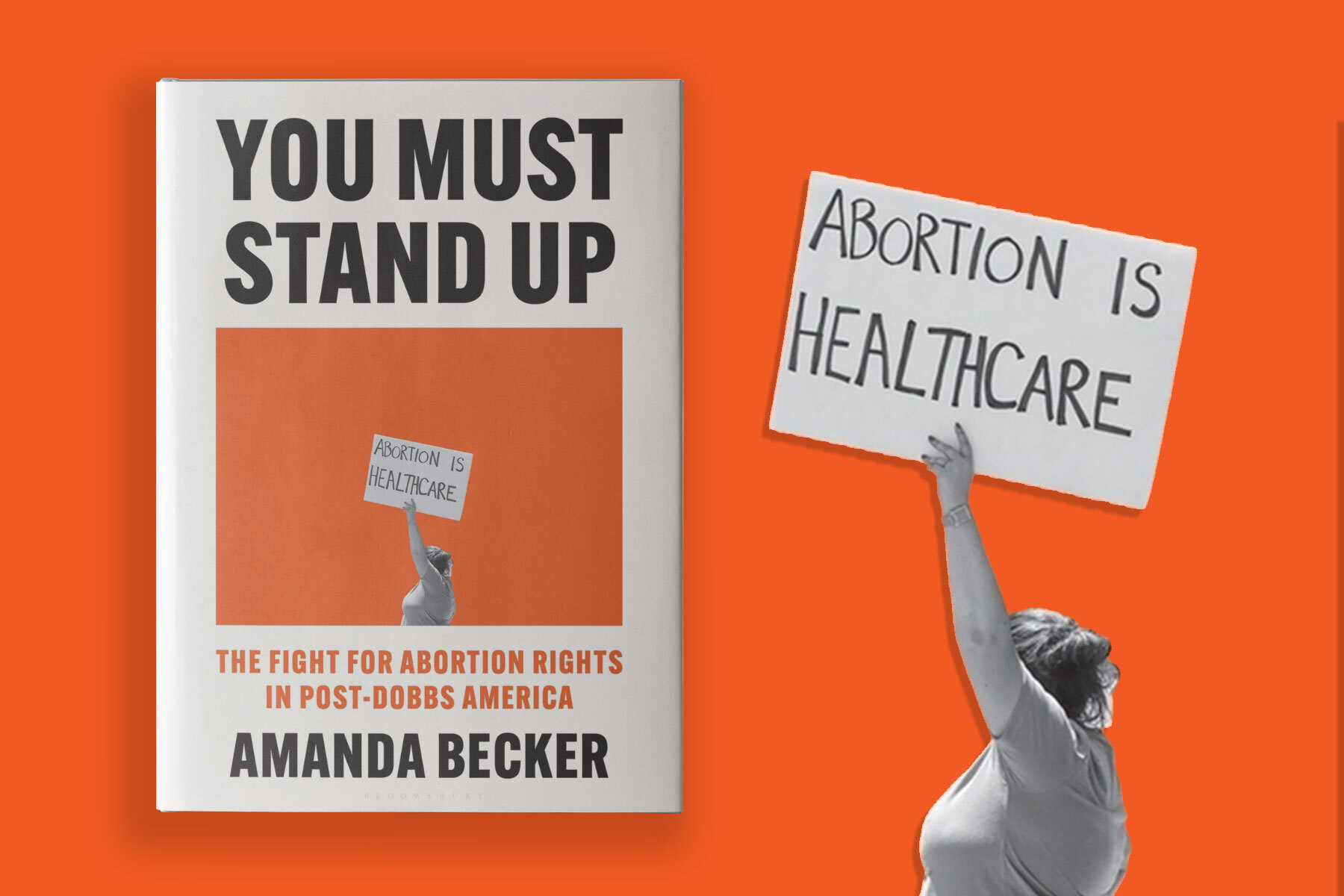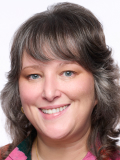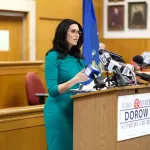This is an excerpt from “You Must Stand Up: The Fight for Abortion Rights in Post-Dobbs America.”
MILWAUKEE — On April Fool’s Day, Daphne Blount and several of her friends headed to Red Arrow Park, a pocket of open space in downtown Milwaukee, across the street from City Hall and a block from the river.
The day was chilly, windy and gray.
Blount handed out blankets from her car and they bundled themselves up in what she called “burrito style.” They’d probably be there for a while — and it wasn’t for pranks. Their excursion that Saturday felt existential: In just three days, there would be a state Supreme Court election that could eventually determine the future of abortion access in Wisconsin.
Blount and her friends drove downtown to support Judge Janet Protasiewicz, the candidate who believed that abortion was a right — not former justice Daniel Kelly, the anti-abortion candidate who had recently appeared alongside a pastor who, years before, had signed a letter saying that killing an abortion provider met the definition of “justifiable homicide.”
For Blount, the stakes in the election weren’t theoretical.
She was a first-year medical student, having returned to her home state of Wisconsin after graduating from the University of Minnesota. She’d been thinking of specializing in women’s health care — now she wasn’t so sure. Weeks before she started med school, the U.S. Supreme Court overturned the constitutional right to abortion in Dobbs vs. Jackson Women’s Health Organization, and a Wisconsin abortion ban from before the Civil War kicked in. Passed in 1849, then updated in 1858, before women could vote or even own property, it criminalized the provision of abortion at every stage of pregnancy. Its only exception was to prevent the death of the person who was pregnant.
“Choosing to go into that specialty if you’re going to stay in the state of Wisconsin, it is going to constantly be an uphill battle,” Blount told me. “So that has certainly been a component of me deciding to open my mind to looking at other specialties. … I do hope to practice in Wisconsin as a physician, I just don’t know if I want to sign myself up to be constantly needing to fight for my patients to have access to human rights, basic reproductive care.”
Several days after the Dobbs ruling, Wisconsin Gov. Tony Evers and Attorney General Josh Kaul, both Democrats — and both up for reelection — filed a lawsuit challenging the 1849 ban. “Half the people who live here are now second-class citizens,” Evers said at a press conference.
The case started making its way through the court system. No matter how a lower court might rule on the century-plus-old law, its supporters and critics both knew that the case would be appealed and end up at the Wisconsin Supreme Court, which — going into the April 2023 election — was split 4 to 3 in favor of conservative justices. But Justice Patience Roggensack, a conservative who sat on the court since 2003, was retiring rather than pursuing a third 10-year term. State Supreme Court elections in Wisconsin are nonpartisan, but Protasiewicz, a county circuit judge in Milwaukee, said that she was running to take on “radical right-wing extremists” who were jeopardizing Wisconsinites’ “most closely held constitutional rights.” Kelly, a conservative appointed to the bench who served for four years before losing reelection in 2020, had also made his politics clear: He was a paid adviser to the state and national GOP as former President Donald Trump ran for reelection in 2020 and contested the former president’s loss in Wisconsin and nationally. “If an activist were to win next April, Wisconsin’s public policy would be imposed by four lawyers sitting in Madison instead of being adopted through our constitutional process,” Kelly said when he announced. “I won’t let that happen on my watch.”
The parameters of the battle to regain abortion rights in Wisconsin were set. Because Wisconsin has no citizen ballot initiative process, courts would be the only realistic route to seek relief from the pre–Civil War abortion ban — as well as from GOP-drawn gerrymandered maps that distorted party representation in the legislature in favor of Republicans. The outcome of the Supreme Court race would determine whether the state’s voters would get a chance for fairer representation in the state legislature — and whether Blount would have the chance to learn how to perform an abortion, not to mention whether she would be able to offer it as an option to her patients when she begins practicing, if she decides to be an OB-GYN in her home state.
Blount was at the pro-Protasiewicz rally due to her involvement with the group Medical Students for Choice (MSFC), a national nonprofit that was founded by student activists back in 1993. When she arrived in Milwaukee for medical school, Blount went to a student organization fair and her school’s chapter of MSFC (as its members often call it) had a table that caught her attention because it seemed like they, in particular, were being “very proactive in trying to make the situation better, get answers for students and fight for better educational access,” she told me.
Blount said she “kind of knew from the moment that Roe v. Wade fell that reproductive justice was going to be an important piece of going to medical school, because how are all the residents and med students in Wisconsin going to get their OB-GYN, family care and primary care education effectively when a very important piece of our education is now up in the air and in limbo?”
Fortunately, Blount entered medical school at a time when many in her chosen profession were newly energized about taking on the role of activist.
After the Affordable Care Act was enacted in 2010, there were immediate and continued attempts to repeal it that prompted some physicians to advocate for a universal health care system. Pediatricians joined the front lines of the fight against gun violence. Doctors watched as the country’s rejection of science worsened during the COVID-19 pandemic. When a Minneapolis police officer killed George Floyd in May 2020, it kicked off a series of nationwide racial justice demonstrations, and members of the national student-run group White Coats for Black Lives took to the streets to protest police violence and systemic racism as a public health crisis.
Blount, who was in Minneapolis the summer of Floyd’s murder, had thought about advocacy as a necessary part of urban and community health as she considered that as a career focus, but it wasn’t until Roe fell that she realized other areas of medical practice — pediatrics, women’s health — might require activism in order to care for her future patients. “I think a big component for me has been feeling this kind of call to advocacy. That wasn’t really on my radar when I applied to medical school,” she said.
When I asked Blount why she might have a greater degree of comfort about activism as compared to medical students more broadly, she pointed to her undergraduate experience at the University of Minnesota, where students were open about changes they wanted to the curriculum and administration; her interest in community health, which brought her to medical school in the first place; and physician mentors who she has been able to emulate.
“I’ve kind of had the perspective that you can’t improve a system without identifying its flaws, so I think I’m a little bit more open to identifying areas where patients care is really limited and where we can improve,” she said.
As the contours of Wisconsin’s Supreme Court election began to take shape, the MSFC chapter at Blount’s school kicked into action. They created informational, nonpartisan flyers that listed candidate endorsements and quotes, noting that Protasiewicz had said “a woman’s right to make decisions over her own body should be just that, not made by the government, but made by the person who’s ultimately being affected.” Kelly, meanwhile, had called abortion “a policy deadly to children.” As the general election drew closer, they distributed leaflets that advised potential voters on how to make sure they were registered, how to find their polling place and provided the deadline for requesting absentee ballots. “The candidate elected in April will play a decisive role in upcoming cases that may include the legality of Wisconsin’s near-complete 1849 abortion ban, fights over legislative redistricting and the power of the executive branch in administering laws,” one leaflet read. MSFC members staffed tables on campus that registered people to vote.
Blount’s membership in the group was how she found herself bundled up like a burrito on a cold Saturday in a downtown park instead of studying or relaxing with her friends.
“I think the biggest thing that has arisen for me over the last year has been this feeling that I can’t be in this profession and not do everything in my power to improve the systemic issues that are really creating barriers for patients,” she said.
Medical Students for Choice was founded in 1993, the year after the Supreme Court affirmed the constitutional right to an abortion in Planned Parenthood v. Casey, but said states could pass restrictions so long as they did not create an “undue burden” for patients seeking abortion care.
It was a time when violence against abortion providers was in the headlines. In December 1991, a masked gunman with a sawed-off 12-gauge shotgun shot and injured two clinic workers at Center Health Center for Women in Springfield, Missouri. In March 1993, in what was described by authorities as a first-of-its-kind slaying, an anti-abortion protester shot and killed 47-year-old Dr. David Gunn at his clinic in Pensacola, Florida — the 1993 murder was the one that the pastor who appeared with Kelly said was a justifiable homicide. Later that year, in August, anti-abortion extremist Rachelle “Shelley” Shannon, affiliated with the Christian terrorist organization Army of God, whose followers had been bombing clinics since the 1980s, shot and wounded Dr. George Tiller at his clinic in Wichita, Kansas. (In 2009, another anti-abortion activist ultimately shot and killed Tiller as he served as an usher during a Sunday morning church service.) “We were created by medical students who were, obviously, feeling the pinch between the constitutional protection of abortion in the U.S. and the reality that abortion providers were being assassinated,” MSFC Executive Director Pamela Merritt told me.
MSFC now has more than 220 chapters at medical schools and in residency programs in more than 20 countries. Its fastest-growing region of membership is the global South — there are chapters in India, Nepal, and Malawi. “Medical Students for Choice fills a unique role helping future physicians reconcile the need for advocacy within their profession,” Merritt said.
While abortion is taught in OB-GYN residency programs, it is not part of the core accreditation curriculum at U.S. medical schools, so students interested in becoming OB-GYNs — or family practice physicians, or anyone who anticipates a need to learn the full spectrum of reproductive care — can turn to MSFC for training they aren’t getting at their colleges and universities. Three or four times a year, MSFC holds very popular classes taught by alumni that students can attend in person or virtually. In one, students use a papaya as a stand-in for a uterus in order to practice manual vacuum aspiration, which can induce an abortion, and clear retained fetal tissue. (The Reproductive Health Access Project, which also aims to fill gaps in clinical education related to reproductive care but for family physicians, recommends finding “a store supplying the smaller ‘Hawaiian’ or ‘Brazilian’ papayas, rather than larger ‘Mexican’ ones…The papayas work best if they are somewhat ripe and not too green, but they do ripen quickly so don’t buy them too far in advance.”)
Medical Students for Choice was already a part of the pre-Dobbs educational safety net, providing trainings, three- to nine-day stints shadowing abortion providers in clinical settings, and financial assistance to set up externships. After Dobbs, depending on the school and state, MSFC programming became an educational lifeline for students who had literally no other route to receive abortion training. “The reality is, medical schools have always been able to fall back, until June of 2022, on the fact that students who are super interested [in learning abortion care] could go to their local clinic and get an elective credit and get training, or the fact that if somebody later goes into residency and decides that they want to be an OB-GYN, then they are going to get that training,” Merritt said.
MSFC also partners with the Center for Reproductive Rights to join lawsuits related to abortion and contraception. MSFC, the National Abortion Federation, Physicians for Reproductive Health, Planned Parenthood, and other similarly aligned groups filed an amicus brief in the Dobbs case when it was before the Supreme Court. Since then, the group filed a friend-of-the-court brief in the lawsuit challenging the FDA’s approval of the abortion drug mifepristone. Anything where “we feel that medical students have a vested interest,” she said.
Merritt also noted that the way that medical education is structured makes student concerns about reprisal for challenging their administrators and schools very real. Many medical schools have for many years shied away from teaching abortion care due to their traditional alignment with the patriarchy, she said.
Plus, she continued, medical schools are bureaucracies that are risk-averse, and their boards often have members who are either small-c or politically conservative. The way medical school administrations are structured vests a lot of power with the deans, who make recommendations for students as they match with residency programs, and can ease — or obstruct — residents who need to travel out of state or to another institution for training. “Basically, the people who are going to recommend you for match, for residency, are the same people that our chapter leaders are trying to get to make change. So the fact that we still have people who are eager and participating always inspires me because it is a scary business, the tragedy being that if you run afoul of your dean, and you don’t get a certain number of recommendations, you’re not going to get a residency. If you get fired from your residency program, you’ve lost your career — not just a job,” Merritt said.
Still another way that MSFC reinforces abortion education is by supporting the medical students who are trying to change school curricula, because the “number one thing — and this predates Dobbs — preventing medical students from getting consistent education is the fact it was not locked into the core accreditation curriculum for medical schools,” Merritt said. “So we have an entire passel of resources and support that we provide for that, and it’s really tailored to the situation, what kind of administration you have, who are your friends and foes, etcetera … a lot of campuses are working on curriculum reform, and even though they might not get a win while they’re in med school, they’re advancing the ball.”
Initial data from the Association of American Medical Colleges on the first post-Dobbs residency matching cycle showed that students were already shying away from applying to programs in states that banned or restricted abortion. Learning to perform abortions is a required component of OB-GYN residencies, so in states where abortion is restricted, training doctors would have to spend time at another hospital out of state, which can be costly and logistically complicated. In states with full abortion bans, the number of OB-GYN residency applicants fell by more than 10 percent in the 2022-2023 cycle as compared to the year before. For states with abortion limits, the number of applicants dropped 6.4 percent, AAMC data showed.
The majority of medical residents ultimately build their practices in the state where they trained — and even before Dobbs, Wisconsin was facing an OB-GYN shortage.
“The reality that advocates and providers need to wrap their head around is that this has done profound damage to the structure of our system and the distribution of OB-GYN providers in the country already — and that is not going to be fixed anytime soon,” Merritt said. Even back in 2016, she said she was thinking: “We need to dig in and really hold the line where we do have adequate care because we’re about to lose it big time, including in the entire South.”
A one-word synonym for digging in and holding the line is activism, and Medical Students for Choice also aims to provide a grassroots education about how physicians can — and should — embrace it as a component of their medical practice. MSFC has shaped the careers of many doctor-leaders in the reproductive justice movement. Dr. Diane Horvath, who started Partners in Abortion Care in College Park, Maryland, founded an MSFC chapter when she was a medical student in Toledo, Ohio. While Dr. Leah Torres traces her initial interest in being a physician back to a women’s studies course at the University of Michigan — where she learned that key medical studies on health issues that disproportionately affected women nevertheless used all-male subjects — she said she realized she wanted to be an OB-GYN in her second or third year of medical school at the University of Illinois Chicago, when she discovered a newly established chapter of Medical Students for Choice.
“I went to a meeting or whatever and found my people, because the whole shtick was abortion, contraception — these are things that are under studied, if not taught at all, in medical school curriculum and we are working to change that and make it more accessible,” Torres said. “I thought: If we’re not learning about it in medical school, that’s a problem. And so started my political advocacy.”
Students, including medical students like Blount who embraced advocacy, were an important part of the coalition working to elect Protasiewicz in a race that The New Yorker described in a headline as a “high-stakes election in the midwest’s ‘democracy desert”’ that “could change the course of the entire country. “
In a boldfaced headline, it read as hyperbole, but the markers were there. By many measures, Wisconsin was the most gerrymandered state in the country. It does not track registered voters by party, but its statewide races, including for presidents, are often decided by a point or two, indicating a relatively evenly split electorate. In the 2022 midterms, Democrats were reelected as governor (Tony Evers), attorney general (Josh Kaul), and secretary of state (Douglas J. La Follette)—but those were statewide offices. In the state legislative races, meanwhile, Republicans retained a disproportionate 64–35 majority in the Assembly and a 22–11 majority in the Senate. Plus, The New Yorker pointed out, the Electoral Integrity Project, founded in 2012 by Harvard University professor Pippa Norris, scored Wisconsin’s electoral maps at 23 out of 100 possible points for their democratic attributes — a score that the magazine noted was “on par with that of the Democratic Republic of the Congo.”
Before the Protasiewicz-Kelly race, the record for the most expensive judicial election in the country was believed to have been set in Illinois, where $15 million was spent in 2004. The amount of money spent in Wisconsin dwarfed that: By the general election on April 4, more than $45 million was spent, with the candidates’ combined campaign expenditures nearing $17 million, and roughly $30 million was spent by outside groups on issue ads and other campaigns, according to records analyzed by OpenSecrets and the nonprofit group Wisconsin Democracy Campaign.
Kelly’s campaign raised the relatively modest sum of $2.6 million, with its largest donations coming from the Republican Party of Wisconsin (about $800,000) and Illinois-based billionaire shipping magnates Elizabeth and Richard Uihlein (together the maximum allowed of $40,000). Longtime Federalist Society adviser Leonard Leo, who guided Donald Trump’s judicial picks, also gave Kelly’s campaign the maximum-allowed donation of $20,000. In outside spending, Fair Courts America — a Uihleins-backed group that promises it is “tracking the woke mob’s activity and are ready to fight for free & fair courts at every level of our government” — spent $5.5 million on Kelly’s behalf. The anti-abortion Women Speak Out PAC, affiliated with SBA Pro-Life America, spent another $2.2 million. Leo’s firm, the Concord Fund, has lobbied for Fair Courts America, while a Leo-affiliated network of dark money groups has spent millions on anti-abortion cases.
Meanwhile, Protasiewicz’s campaign raised $14 million, with nearly $9 million of that coming from the Wisconsin Democratic Party, along with strong support from individual donors who identified themselves as lawyers, from the securities and investments sector, educators, and health care professionals. In outside spending, A Better Wisconsin Together Political Fund, which pools money from liberal-leaning donors like labor unions and Democratic redistricting groups, spent $6.2 million on Protasiewicz’s behalf. A notable individual among the fund’s backers was Lynde B. Uihlein, who in 1990 founded the nonprofit Brico Fund, which supports feminist, environmentalist, and progressive projects in the state — she is also the Wisconsin-based cousin of the conservative power couple who supported Kelly.
It was unclear at first whether the stunning amount of money spent on the race would increase voter turnout — but the primary offered a preview. The judiciary had traditionally been an issue that mobilized conservative voters more than liberal voters, both nationally and within states, but there were signs that key progressive constituencies like students were more engaged than ever before even though the general election would happen in an off year, in an odd month.
The Milwaukee Journal Sentinel reported in early March that a dining hall on the University of Wisconsin–Madison campus, which typically had about 50 voters who participated in spring primary elections, had 515 ballots cast in the Supreme Court primary. A dorm on the same campus had a 39 percent turnout rate. A local elections supervisor told the newspaper that turnout was so high in the primary that some polling locations had to print more ballots, and there was noticeably high participation among young people and women, two demographic groups that tend to disproportionately back progressive candidates and causes — and support reproductive rights.
Ben Wikler, chair of the Wisconsin Democratic Party, told me that he believed that the backlash among the state’s women and young voters to Trump’s presidency — and the state GOP’s continued insistence that Trump won Wisconsin in 2020 despite all evidence to the contrary — is one reason why Wisconsin was still a swing state, unlike neighboring Iowa or nearby Indiana. “They have refused to let up for even a second,” he said.
On April 4, close to 40 percent of Wisconsin’s voting-age population cast ballots in the Protasiewicz-Kelly race — a higher turnout than in any other Wisconsin Supreme Court election in nearly 25 years that didn’t coincide with a presidential primary. Wikler noted that a “small shift” in any demographic, whether it’s increased rural engagement or campus turnout or enthusiasm from Black or Latinx voters — “all of those things can determine a statewide election here.”
When the race was called for Protasiewicz, it was a decisive 11-point victory in a state where four of the last six presidential elections were decided by less than a single point. The British newspaper The Guardian reported that it “amount[s] to a political earthquake in Wisconsin, one of America’s most volatile political battlegrounds.” NPR said that “the win by Protasiewicz comes at a pivotal time for the court, and for the Democratic voters who carried her to office.” An NBC News headline blared: “Liberals gain control of the Wisconsin Supreme Court for the first time in 15 years.” The New York Times declared that voters “chose to upend the political direction of their state. …The result means that in the next year, the court is likely to reverse the state’s abortion ban and end the use of gerrymandered legislative maps drawn by Republicans.”
If the 1849 abortion ban found its way to the state Supreme Court, the justices would likely vote to overturn it.
For Blount — and her fellow medical students — it was a potentially life-changing opening. Maybe it would be possible to get an education here. Maybe it would be possible to practice medicine here. Maybe it would be possible to build a life here.
Excerpted from “You Must Stand Up: The Fight for Abortion Rights in Post-Dobbs America” by Amanda Becker. Used with the permission of the publisher, Bloomsbury. Copyright © 2024 by Amanda Becker.
The 19th has a relationship with Bookshop.org. If you make a purchase through the Bookshop links on our site, we may earn an affiliate commission.





